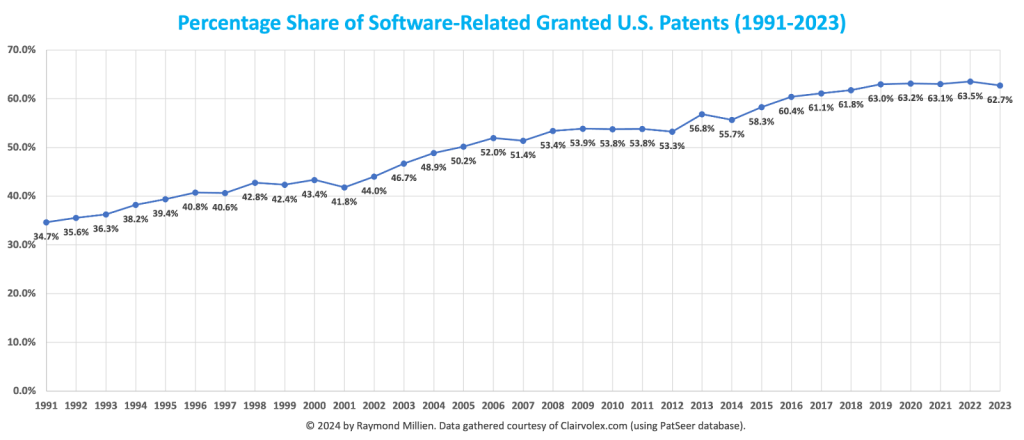Nearly 63% of all U.S. utility patents granted in 2023 were software-related, with the USPTO issuing over 348,000 patents total—yet most website entrepreneurs still believe their digital innovations can’t be patented. This misconception costs founders millions in unprotected intellectual property and missed competitive advantages.
In today’s digital age, protecting your website’s innovative idea is more important than ever, as digital technology shapes how intellectual property is created, shared, and secured.
The reality is more nuanced: while you can patent an innovative idea for a website, the process requires navigating complex eligibility standards that have evolved significantly since the Supreme Court’s 2014 Alice v. CLS Bank decision. Recent USPTO guidance from mid-2024 explicitly affirmed that AI and software inventions remain patentable if they provide specific practical applications, and U.S. courts in 2024-2025 have consistently upheld well-drafted software patents that solve technical problems with concrete solutions.
Key Requirements for Website Patent Eligibility
Your website idea must meet three fundamental criteria established by the USPTO:
- Novelty: The innovation must be new and not previously disclosed to the public. With over 466,000 U.S. utility patent applications filed in FY2024, thorough prior art searches are essential.
- Non-obviousness: An expert in the field shouldn’t find it an obvious development over existing solutions. This bar has risen as software patents have become more common.
- Usefulness: The invention must demonstrate practical application with real-world utility. Abstract business concepts won’t qualify—you need a concrete technical implementation.
Only a patentable invention that meets all legal requirements—including these criteria and any statutory or procedural standards—can proceed to patent protection.
The key distinction lies in technical specificity. Generic business methods like “an online marketplace for tutors” won’t qualify, but a novel authentication algorithm for securing tutor-student connections might. As patent attorney analysis shows, successful software patents now focus on specific technical improvements rather than broad conceptual claims.
Current Legal Landscape and Recent Trends
The patent landscape for software has shifted dramatically, influenced by recent changes in patent law that have redefined the standards for website and software patents. AI-related patent grants in the U.S. reached approximately 8,600 in 2024, part of a broader upward trend that totaled over 54,000 global AI patent grants, reflecting sustained growth in AI innovation. Meanwhile, the SaaS sector has seen an 18.48% annual rise in patent filings. Even educational technology is experiencing patent activity as startups protect novel web-based learning features.
For SaaS founders specifically, understanding these trends is crucial for competitive positioning. Our comprehensive SaaS Patent Guide 2.0 breaks down the specific considerations for software-as-a-service innovations.
Recent Federal Circuit cases demonstrate that courts will uphold software patents with precise technical specifications. When an online payments system patent was challenged in 2025, the court upheld it because the claims described exactly how the system worked in technical terms, rather than claiming the abstract idea of online payments.
The USPTO’s 2024 guidance on AI-related inventions provides examiners with specific examples for determining subject-matter eligibility, creating more predictable outcomes for software patent applications. For AI innovators, our AI Patent Mastery resource offers detailed strategies for navigating these evolving standards. Obtaining a patent under current patent law provides strong legal protection for website innovations, helping to safeguard intellectual property and enhance competitive advantage.
Types of Patents for Website Innovations
Utility Patents
Utility patents protect functional aspects of your website—the processes, algorithms, and methods that make it work. These represent about 90% of all issued patents and can cover:
- Novel algorithms or software techniques (like a new encryption method for secure logins).
- Unique business processes implemented technically (such as a specific matching system in an online marketplace).
- Server-side technologies or systems (improved load-balancing methods or novel database structures).
- Interactive functionality with technical effects (particular methods for real-time collaborative editing).
Claims in utility patents are typically written as method claims (steps performed by servers or user devices) or system claims (components configured to perform specific functions). With software-related patents comprising roughly 63% of U.S. patent grants in 2023, utility patents continue to be the primary protection for digital product functionality.

Design Patents
A design patent explicitly protects the ornamental appearance and unique visual aspects of a website, such as its graphical user interface (GUI) designs, distinctive layouts, or unique visual elements. Unlike utility patents, which cover the functionality of an invention, a design patent protects only the appearance of an invention.
A design patent protects the visual appearance of a website, not its functional features. This means that the design patent protects the unique aesthetic elements that set your website apart from others.
Tech companies actively use design patents: Apple obtained design patents on iPhone screen icons and layouts, which proved valuable in litigation against Samsung. For websites, a design patent might cover distinctive dashboard layouts, specific visual animations, or unique interactive elements.
Design patents are narrower in scope but faster to obtain (typically 1-2 years) and require no maintenance fees. They last 15 years from issuance and can complement utility patents by protecting the visual aspects of your innovation.
Provisional Patent Applications
Provisional patent applications serve as placeholders, securing a filing date while you further develop your invention. They’re particularly valuable for website innovations because:
- The tech world moves fast—you can pitch to investors or test with users while maintaining “Patent Pending” status.
- They cost less and have fewer formal requirements than non-provisional patent applications.
- You have 12 months to file the corresponding utility application.
- Multiple provisional patent applications can be referenced by one non-provisional patent application if you make incremental improvements.
The quality of your provisional patent application affects the level of benefit you receive. Treat it like a complete application in terms of detail—whatever you don’t describe adequately can’t be claimed later with that priority date.
The RLG Advantage: Unlike traditional hourly billing, which can create uncertainty, we offer transparent, fixed-fee pricing for provisional patent applications. You’ll know exactly what your investment will be upfront, with no surprise bills during the process.
After filing a provisional patent application, you must file a non-provisional patent application within 12 months to continue the patent process.
How To Patent Website Ideas: Step-by-Step Process
1. Conduct a Comprehensive Patent Search
Start with free tools like the USPTO’s Patent Public Search system and Google Patents. Use varied keywords and synonyms—if your idea involves “online tutoring,” also search “educational platform,” “tutoring matching system,” and related terms. Utilizing online databases is essential for conducting a thorough patent search and identifying existing patents that may be similar to your invention.
Pay attention to classification codes. Software patents often fall under classes like G06F (Electrical Digital Data Processing) or G06Q (Business Methods). Search international patents via WIPO’s PATENTSCOPE since any public disclosure worldwide counts as prior art. Research existing patents and other inventions in your field to ensure your idea is unique and to avoid potential infringement or rejection.
Don’t limit searches to patents. Academic papers, technical blogs, and product releases all constitute prior art. A general web search for “startup doing X” or “new app for Y” can reveal public disclosures that patent databases might miss.
2. Develop Detailed Documentation
Create comprehensive descriptions that enable another expert to recreate your invention. It is essential to include a detailed description in your documentation to meet USPTO requirements and ensure your invention is thoroughly understood and replicable. For websites, this includes:
- Flowcharts of user interactions and system processes.
- Pseudocode or simplified code snippets illustrating crucial algorithms.
- Database schema diagrams and system architecture overviews.
- Screenshots or wireframes of innovative user interface elements.
Strong documentation satisfies USPTO enablement requirements under 35 U.S.C. §112 and strengthens your position if the patent faces challenges later.
3. Choose Application Type
Consider starting with a provisional application if:
- You’re still refining the invention.
- You want to test market reaction while maintaining “patent pending” status.
- Budget constraints initially make the full utility application cost prohibitive.
4. Draft the Application
A complete utility patent application includes:
Before you can patent an idea, it’s essential to understand that you cannot patent an idea alone; you must submit a complete application with all required elements that comprehensively describe and enable your invention.
- Application Data Sheet (ADS): Bibliographic information, inventor details, and entity status declarations.
- Specification: A detailed written description that enables the reproduction of your invention. For websites, describe system architecture, user workflows, algorithms, and security measures in sufficient detail.
- Claims: The legal heart of your patent. Begin with broad, independent claims that cover core innovations, followed by narrower, dependent claims that add specific features. Use precise language—avoid marketing terms or vague concepts, such as “optimal” or “intelligent.”
- Drawings: Flowcharts, block diagrams, GUI screenshots with labeled elements, network diagrams showing client-server interactions, and database relationships.
5. File Electronically
As of 2025, the USPTO’s Patent Center handles a majority of applications electronically. Filing a patent application online offers significant advantages, such as faster processing and easier tracking compared to traditional paper filing. Electronic filing offers:
- Instant submission confirmation with application number and filing date.
- Lower fees compared to paper filing.
- Easier status tracking throughout the examination process.
- Faster processing by USPTO systems.
Ensure completeness before filing—missing elements can delay your filing date or require costly corrections.
6. Navigate USPTO Examination

Most applications receive initial rejections—this is normal. Common issues include:
- Section 102/103 rejections citing prior art for novelty or obviousness.
- Section 101 rejections for abstract ideas (the Alice problem).
- Section 112 issues regarding claim clarity or specification support.
Patent attorneys prove invaluable during this phase, crafting responses that address examiner concerns while preserving the scope of the claims. Studies show that when applicants pursue appeals, about 75% of applications are eventually allowed, including those granted before formal Board decisions.
7. Maintain Your Patent
Utility patent maintenance fees increased in 2025 to $2,150, $4,040, and $8,280 for large entities, representing approximately 7.5% increases from previous levels. Missing these payments causes your patent to lapse into the public domain.
Examination Fees and Costs
Examination fees are a fundamental part of the patent application process and should be carefully considered when planning to patent a website idea. These fees are paid to the patent office to cover the cost of having a patent examiner review your application and determine whether your invention meets the requirements for patent protection. For utility patent applications, examination fees can range from as low as $176 for micro entities to $880 for large entities, depending on the size of your business and the complexity of your invention.
It’s important to remember that examination fees are just one component of the overall cost of obtaining a patent. You’ll also need to budget for patent search fees, drafting and filing fees, and, if your patent is granted, ongoing maintenance fees to keep your patent active. Working with a registered patent attorney can help you navigate the fee structure, identify any discounts you may qualify for, and ensure that your patent application is prepared correctly to avoid unnecessary expenses or delays.
By understanding the full scope of costs—including examination fees—early in the patent process, you can make informed decisions about how to protect your website idea and allocate resources effectively. A patent attorney can also help you strategize the best approach for your specific situation, ensuring you maximize your investment in intellectual property protection.
Common Mistakes to Avoid When Patenting Website Ideas
Patenting website ideas can be a complex journey, and avoiding common mistakes is crucial to securing strong intellectual property protection. One of the most frequent errors is skipping a comprehensive patent search before filing your patent application. Overlooking existing patents or prior art can result in costly rejections and wasted time.
Another pitfall is attempting to navigate the patent process without the guidance of a patent attorney or patent lawyer experienced in website innovation and intellectual property. A professional can help you draft a robust application, select the right type of protection—such as utility patents or design patents, and ensure compliance with all relevant patent laws.
Failing to respond promptly to communications from the patent office, such as office actions or requests for clarification, can jeopardize your patent rights. Missing deadlines or neglecting to pay maintenance fees can also cause your patent to lapse, leaving your website idea unprotected.
Additionally, misunderstanding the differences between provisional patents and non-provisional patent applications, as well as the requirements for each, can lead to incomplete or invalid filings. By working with a knowledgeable patent attorney and staying proactive throughout the patent process, you can avoid these common mistakes and increase your chances of successfully patenting your website ideas.
Responding to Patent Office Objections
Receiving objections from the patent office is a regular part of the patent process, especially for website innovations, where questions of abstract ideas and patentable subject matter often arise. When a patent examiner issues an office action or raises concerns about your application, it’s essential to respond thoughtfully and within the required timeframe to keep your patent application moving forward.
A patent attorney or patent lawyer can be invaluable in this stage, helping you interpret the examiner’s objections and craft a persuasive response. This may involve amending your claims to clarify your invention, providing additional technical details, or presenting legal arguments that demonstrate your website idea meets the requirements of patent laws, such as non-obviousness and eligibility.
If your response does not resolve the examiner’s concerns, you may have the option to appeal to the Patent Trial and Appeal Board. Understanding the nuances of abstract ideas, patentable subject matter, and the standards applied by the patent office is critical to overcoming objections and ultimately securing patent protection. By working closely with a patent attorney, you can navigate this process with confidence and improve your chances of a successful outcome.
International Patent Protection for Website Innovations
In today’s digital age, website innovations often have global reach, making international patent protection a key consideration for forward-thinking entrepreneurs. While the United States Patent and Trademark Office (USPTO) provides a pathway for securing patent rights in the U.S., protecting your website idea in other countries requires additional steps.
The Patent Cooperation Treaty (PCT) streamlines the international patent process by allowing you to file a single international patent application, which can then serve as the basis for seeking patent protection in over 150 countries. A patent attorney can guide you through the initial filing, help you understand the publication fee and issue fee requirements, and coordinate with foreign patent offices to ensure your intellectual property rights are protected worldwide.
It’s essential to acknowledge that patent laws and examination standards differ from country to country. Working with a patent attorney who understands these differences can help you develop a global patent filing strategy that maximizes your competitive edge and prevents others from exploiting your innovation in international markets. By planning ahead and budgeting for the whole patent filing process, you can secure robust patent protection for your website idea wherever your business grows.
Real-World Success Stories
Website patents are not limited to physical inventions—digital innovations can also be protected.
Amazon’s 1-Click Checkout: Filed in the late 1990s, this patent gave Amazon exclusive rights to single-click purchasing until its 2017 expiration. This brilliant idea was protected by a patent, allowing the company to license the technology to others, including Apple for iTunes purchases, and demonstrating how a straightforward technical implementation can become a competitive advantage.
Facebook’s News Feed: Facebook secured a 2010 patent for the social networking activity stream concept. While news feeds became ubiquitous across platforms, Facebook’s early patent provided defensive value and illustrated how first-mover advantage in web functionality can translate to intellectual property protection.
Blackboard’s Mixed Results: The educational technology company’s broad LMS patent claims faced challenges when the Federal Circuit invalidated many as indefinite or obvious. This case highlights the importance of specific technical innovations over generic system descriptions.
Working with Patent Attorneys
Patent attorneys bring crucial expertise in several areas. Working with a law firm that specializes in intellectual property ensures you have professional guidance through every stage of the patent process.
Technical Translation: They help articulate your innovation in language that meets USPTO requirements, particularly important for overcoming abstract idea rejections under Alice.
Claim Strategy: Experienced attorneys craft claims that maximize protection while distinguishing from prior art, often meaning the difference between patent grant and rejection.
Prosecution Management: They handle Office Action responses, examiner interviews, and the complex back-and-forth that characterizes most patent prosecutions.
Cost Consideration: While attorney fees add expense, patent lawyers can help manage the costs and complexities of the patent process. Poorly drafted applications often cost more in the long run through failed prosecutions or weak patents vulnerable to challenges.
At RLG, we specialize in tech IP and understand the unique challenges facing SaaS founders and AI innovators. Our fixed-fee approach eliminates billing uncertainty, and our deep experience with software patents means we know how to position your innovation for success from day one.
Alternatives and Complementary Protection
Copyright Protection
Your website’s code, content, and design elements receive automatic copyright protection upon creation. This covers:
- HTML, CSS, JavaScript, and server-side code.
- Original written content and blog posts.
- Unique graphics and visual designs.
- Audiovisual elements and interactive media.
Copyright prevents direct copying but won’t stop someone from creating similar functionality with different code. For addressing wholesale copying of design or content, copyright provides faster, less expensive remedies than patent litigation.
Trademark Protection
Protect your brand identity through trademark registration:
- Website name and service brand.
- Distinctive logos and visual identifiers.
- Memorable taglines tied to your service.
- Even unique domain name patterns in some cases.
Trademarks prevent customer confusion and protect brand reputation. Unlike patents, trademarks can last indefinitely with proper renewal and continued use.
Trade Secrets
Keep confidential any proprietary information that provides a competitive advantage:
- Server-side algorithms not visible to users.
- Proprietary datasets and processing methods.
- Unique business strategies and operational procedures.
- Customer lists and internal analytics.
Trade secrets require reasonable measures to maintain secrecy (such as NDAs, access controls, and security protocols), but they can last indefinitely. They work best for innovations that can’t be reverse-engineered from your public-facing product.
Strategic Considerations
Hybrid Approach: Most successful web companies use multiple protection types. Patent core functionality, trademark your brand, copyright your content/design, and maintain trade secrets for internal processes.
Cost-Benefit Analysis: Patents involve significant time and money. Prioritize applications for foundational technology that could become central to valuation or defensive strategy against larger competitors.
International Considerations: File foreign patents within 12 months of your U.S. filing to claim priority under international treaties. The Patent Cooperation Treaty (PCT) process can streamline the international application process.
Timing Strategy: In fast-moving tech sectors, consider provisional applications to secure early filing dates while you refine implementations and gauge market response.
For SaaS companies planning international expansion, our SaaS Agreement Checklist covers the legal considerations beyond just IP protection.
Conclusion
The landscape for patenting website ideas continues evolving, with courts and the USPTO providing more explicit guidance on software patent eligibility. Recent data showing software-related patents comprising nearly two-thirds of all U.S. utility patents demonstrates that well-crafted applications can successfully navigate current legal standards.
Success requires focusing on concrete technical solutions rather than abstract business concepts. Whether you’re developing novel AI algorithms, unique user interaction methods, or innovative system architectures, patent protection can provide valuable competitive advantages when properly pursued.
The key lies in understanding that patents protect specific implementations, not broad ideas. By thoroughly documenting your technical innovations, conducting comprehensive prior art searches, and collaborating with experienced patent professionals when the stakes are high, you can effectively protect your website innovations while building valuable intellectual property assets for your business.
Your Next Steps to Website Patent Success
Protecting your website innovation isn’t just about legal compliance—it’s about securing competitive advantages that can define your market position and valuation for years to come. With software patents comprising the majority of all U.S. patent grants, the landscape clearly favors well-prepared innovators who understand how to navigate the system effectively.
The bottom line is that weak patents invite competitors to copy your innovations and undercut your market position. In contrast, strong patents create defensive moats that deter competition and attract investor confidence. The difference often comes down to professional preparation and strategic timing.
Your hesitation costs you market control. Every day without patent protection is another day competitors can freely copy your innovations, raise competing funds using your ideas, and establish market positions that should rightfully be yours. In our first-to-file system, the inventor who files first wins—regardless of who actually invented it first.
Here’s your immediate action plan:
- Schedule a Free IP Strategy Call to evaluate your website innovation’s patentability and develop a customized protection strategy that aligns with your business goals and timeline.
- Conduct a comprehensive prior art search using the resources outlined above, or engage our team for a professional patentability analysis that uncovers hidden risks and opportunities.
- Document your innovation thoroughly with detailed technical specifications, flowcharts, and architectural diagrams that clearly demonstrate your novel approach.
- Consider provisional filing if you’re still refining your invention but want to secure an early priority date while testing market response.
The future belongs to innovators who protect their intellectual property strategically. Your website innovation represents countless hours of development and potentially millions in market value—professional patent protection ensures you maintain control over that investment while building assets that enhance your company’s valuation and competitive position.
Get Your Patent Application approved or pay nothing. We guarantee it.
We’re so confident we’ll get your patent application approved that if your patent gets rejected, we’ll issue a 100% refund. No questions asked.
- FREE strategy call with RLG team
- Experienced US patent attorneys lead the application from start to finish
- One transparent flat-fee covering the entire patent application process (including office actions)
- Full refund if USPTO denies patent application*
- Full refund or additional searches if the application has patentability issues (your choice)*
Don’t let competitors capitalize on your innovations while you’re left wondering “what if.” The time to act is now.
Frequently Asked Questions
Can I patent an entire website? You cannot patent a website as a whole, but you can patent specific innovative processes, methods, or visual designs it incorporates. Focus on the unique technical aspects that differentiate your site from existing solutions.
What’s the difference between utility and design patents for websites? Utility patents protect how your website works (functionality, processes, algorithms), while design patents protect how it looks (GUI layout, visual elements, interface design). Many companies pursue both types for comprehensive protection.
How long does the patent process take? Current USPTO averages indicate 16-18 months for the first Office Action, with an overall pendency of around 23 months to final decision. Expedited examination options like Track One can reduce this to 12 months for additional fees.
What makes a website innovation patentable versus abstract? Post-Alice cases demonstrate that specific technical improvements to computer functionality or unconventional solutions to technical problems are eligible for patenting. Vague business concepts or generic computer implementations do not.
Should I file a provisional application first? Provisional applications work well for website innovations because they secure early filing dates while you refine your concept, test with users, or seek funding. The 12-month window provides valuable development time while maintaining “patent pending” status.
Author: Andrew Rapacke, Managing Partner, Registered Patent Attorney
Connect with us: LinkedIn: Andrew Rapacke | Twitter: @rapackelaw | Instagram: @rapackelaw




